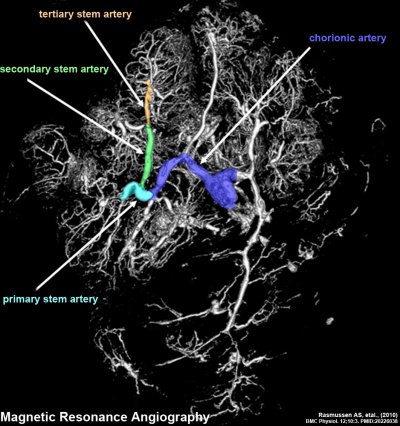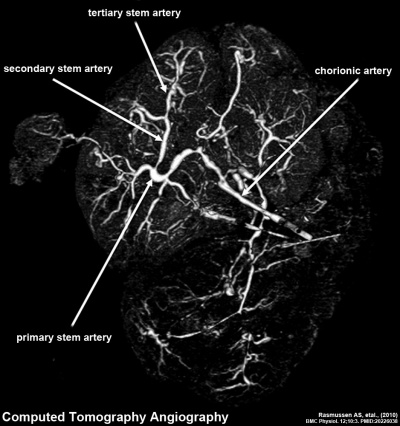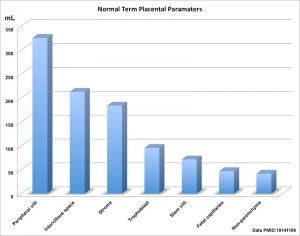BGDA Practical Placenta - Placental Functions
From Embryology
| Practical 14: Implantation and Early Placentation | Villi Development | Maternal Decidua | Cord Development | Placental Functions | Diagnostic Techniques | Abnormalities |
Term Placenta
Placenta Vasculature - MRI and CT
Term placenta viewed from the fetal side.[1]

|

|
| Magnetic Resonance Angiography (MRA) | Computed Tomography Angiography (CTA) |
Legend
|
Exchange

|

|
- oxygen, carbon dioxide, carbon monoxide
- nutrients
- water, glucose, vitamins
- electrolytes
- waste products
- urea, uric acid, bilirubin.
- hormones
- mainly steroid, protein hormones poorly transported.
- maternal thyroid hormone can slowly cross.
- fetal insulin can impact on maternal diabetes.
- maternal antibodies
- maternal IgG antibodies are transferred from about week 13 (GA) across the placenta
- from the maternal lacunae syncytiotrophoblast cell endosomes bind IgG through neonatal Fc receptors.
- drugs and their metabolites
- pre-existing maternal conditions
- illegal drugs (fetal drug addiction)
- infectious agents
- cytomegalovirus, rubella, measles, malaria, listeria, microorganisms
Endocrine
Protein and steroid hormones.
- Human chorionic gonadotrophin (hCG) - like leutenizing hormone, supports corpus luteum in ovary, pregnant state rather than menstrual, maternal urine in some pregnancy testing
- Human chorionic somatommotropin (hCS) - or placental lactogen stimulate (maternal) mammary development
- rise through pregnancy, stimulates maternal metabolic processes, breast growth
- Human chorionic thyrotropin (hCT)
- Human chorionic corticotropin (hCACTH)
- Relaxin
- Steroid Hormones - progesterone (maintains pregnancy), estrogens (fetal adrenal/placenta)
Placental Metabolism
Synthesises - glycogen, cholesterol, fatty acids
- provides nutrient and energy
| Practical 14: Implantation and Early Placentation | Villi Development | Maternal Decidua | Cord Development | Placental Functions | Diagnostic Techniques | Abnormalities |
Additional Information
| Additional Information - Content shown under this heading is not part of the material covered in this class. It is provided for those students who would like to know about some concepts or current research in topics related to the current class page. |
- ↑ <pubmed>20226038</pubmed>| BMC Physiol.
Placenta Measurements
Morphometric indices at term of placental composition, villous capillarization and the mean cross-sectional areas of peripheral villi and capillaries.
| Variable | Unit | Placenta |
| Intervillous space | mL | 213 |
| Stem villi | mL | 71.4 |
| Peripheral villi | mL | 326 |
| Trophoblast | mL | 95.5 |
| Stroma | mL | 184 |
| Fetal capillaries | mL | 46.9 |
| Non-parenchyma | mL | 41.5 |
| Peripheral villi | km | 89.2 |
| Fetal capillaries | km | 310 |
| TS area villi | µm2 | 3700 |
| TS area capillary | µm2 | 150 |
| Capillaries | mL mL-1 | 0.147 |
| Length ratio | km km-1 | 3.6 |
Data from a study sample of 15 normal placenta, mean placental volume, 652 ml.[1][2]
| Measurement methodology |
|---|
|
Drugs
- Abnormal Development - Drugs - The placenta and fetal tissues may deal with drugs differently from adult target tissues. In particular, drugs are "cleared", metabolised and excreted, at a different rate in both the fetus and in newborn infants. In general there is a much lower rate of clearance.
<pubmed>21766440</pubmed> <pubmed>21789231</pubmed> <pubmed>19732616</pubmed>| PMC2767264
| Practical 14: Implantation and Early Placentation | Villi Development | Maternal Decidua | Cord Development | Placental Functions | Diagnostic Techniques | Abnormalities |

